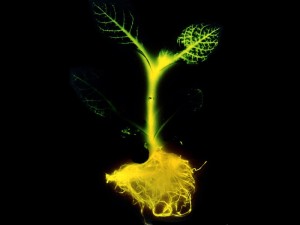Glowing Plants: They’re Real And They’re Here
Not only are luminescent plants real, you can buy the seeds to plant one right now.
Could glowing plants one day be used to light up entire cities?
You may remember an article on Astounde last year about Christmas trees that glowed without the need for electricity. Now, a Kickstarter campaign assembled by members of the Singularity University and Stanford University is tapping into this same technology and science to bring glowing plants to your home by 2014.
Luciferase: The Light-Up Gene
The campaign, which has already met it’s proposed $65,000 fundraising goal (and still climbing), uses synthetic biology to fuse the glowing traits of jellyfish into the plants we see everyday.
This was made possible by extracting bioluminescence genes, fittingly named luciferase, and blending them into a small plant called Arabidopsis, a cousin to mustard and cabbage. Luciferase is also the gene responsible for providing fireflies with their shine.
DNA Architects
The team is actually able to code DNA using a genome compilation software, and are hard at work to find the perfect recipe.
As the research is in its initial stages, they expect that first generations will only possess dim glow properties, but they hope that down the line, these plants could supplant our electric and gas lighting infrastructure.
Count Me In!
For just $40, you can get 50-100 seeds that will sprout into polarizing plants shipped to you by 2014.
“We live in a world that is generating too much carbon dioxide,” said Project Manager Antony Evans. “Nature has figured out ways of creating energy that don’t require so much CO2 use, and what we really want to do is awaken people to the potential of that. Instead of having all these expensive street lights, why don’t we get plants?”
Is it safe?
Worried that glow plants could spread and take over the planet? The team has thought of that, specifically utilizing Arabidopsis, a plant known to be weak in that regard.
The head of Genetics at Harvard Medical School, George Church, described the project as being “as safe as it gets”. The genes being introduced into nature are non-pathogenic and non-toxic as well.
The Future
With the crowdfunding cash, the team hopes to find the perfect spliced blend to create a commercial model to send out into nature.
“What I would really like to do one day is a willow tree, but genetically engineering trees is pushing the boundaries of science that we’re not ready for” said Evans.
“I firmly believe that this is something that’s going to revolutionize our society. With this technology we have a lot of tools that can solve a lot of humanity’s problems. We’re limited only by our imagination.”
GlowingPlant, Kickstarter via Singularity Hub
Comments
Tags: glow plants, glowing plants, green lights, green plants, light plants, light up plants, luciferase, plant lights
Trackback from your site.

